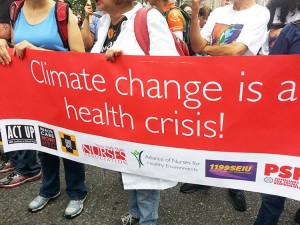Some 9 Ways Climate Change Is Making Us Sick
From an Article by Reynard Loki, AlterNet, April 16, 2016
The Obama administration has released a major new report on how manmade global warming is making Americans sicker—and it’s only going to get worse.
Developed over three years and involving approximately 100 climate and public health experts, the 332-page report was based on more than 1,800 published scientific studies and new federal research and was reviewed by the National Academies of Sciences.
The report, The Impacts of Climate Change on Human Health in the United States, “significantly advances what we know about the impacts of climate change on public health and the confidence with which we know it,” according to a White House fact sheet about the report.
“As the climate continues to change, the risks to human health will grow, exacerbating existing health threats and creating new public health challenges and impacting more people in more places,” the fact sheet states. “From children to the elderly, every American is vulnerable to the health impacts associated with climate change, now and in the future.”
The report also involved the participation of representatives from a number of federal departments and agencies, including the U.S. Environmental Protection Agency (EPA), the Department of Health and Human Services, the National Oceanic and Atmospheric Administration, the National Aeronautics and Space Administration, the Department of Agriculture, the U.S. Geological Survey, the Department of Defense and the Department of Veteran’s Affairs..
“It’s not just about polar bears and melting ice caps,” said EPA Administrator Gina McCarthy at a White House event unveiling the report. “It’s about our families. It’s about our future.”
Surgeon General Vivek Murthy said that climate change affects more people in more ways than doctors are accustomed to seeing. Noting that the report will help doctors to quantify “the sheer number of pathways through which climate affects health,” Murthy called out increased pollen, wildfire and air pollution exacerbated by emissions from power plants as emergent climate change-related threats to public health.
Here are nine ways global warming increases health risks.
1. Increased Asthma and Respiratory Illness
The report projects that by 2030, due to “future ozone-related human health impacts attributable to climate change,” the U.S. can expect to see hundreds or even thousands of premature deaths, not to mention increases in hospital admissions and cases of acute respiratory illnesses every single year.
The report underscores the particular impact on children. Due to their immature respiratory and immune systems, kids can expect to experience more episodes of asthma and other adverse respiratory effects due to climate change. “Not being able to breathe is one of the most frightening experiences” a person can have, Surgeon General Murthy said. “We’re talking about scary moments for parents and children.”
An estimated five million children in the U.S. currently suffer from asthma, the most common chronic disease among children, According to the Children’s Hospital of Philadelphia, “asthma is the number one reason that children miss school, go to emergency rooms and are admitted to hospitals.”
“Now we’re seeing [asthma] worsening because of the heat, the allergens [and air pollution],” said Lynn Goldman, dean of the George Washington University’s public health school.
2. Worsening Allergies
Every spring, flowers bloom and with them, pollen spores are spread throughout the air, increasing allergies. With warming temperatures ushered in by climate change, the pollen season has lengthened, exacerbating the symptoms of hay fever for an estimated 40 million Americans who suffer from allergies, triggering annual healthcare costs of more than $21 billion.
Between 1995 and 2011 in central North America, the ragweed pollen season has increased by as much as 11 to 27 days. That has already had significant impacts on some 6.8 million kids who are susceptible to allergens.
3. Premature Deaths from Extreme Heat
White House science adviser John Holdren underscored the looming threat of increased heat waves, warning that greenhouse gas reductions at this point won’t stop fatalities caused by increased temperatures. “We can see thousands to tens of thousands of heat-related deaths in the United States each summer,” he warned.
These premature deaths are expected to outpace projected deaths due to extreme cold. The western part of the country, in particular, will experience an increase in both the frequency and intensity of heat waves. Using a 1990 baseline for more than 200 U.S. cities, one model projected an increase of more than 11,000 additional deaths during the summer in 2030, rising to 27,000 more deaths by the summer of 2100.
4. More Cases of Lyme Disease
Between 2001 and 2014, both the distribution and the number of reported cases of Lyme disease increased in the Northeast and Upper Midwest. The number is set to increase as warmer temperatures impact both the winter and spring months, leading to an earlier annual onset of the Borrelia bacteria that causes the disease. Research indicates that the geographical distribution of ticks carrying the bacteria is “expected to expand to higher latitudes and elevations in the future.”
The annual incidence of Lyme disease is calculated as the number of new cases per 100,000 people. The graph is based on cases that local and state health departments report to the Center for Disease Control’s national disease tracking system. Image: EPA; Data: Center for Disease Control 2015
Note: Part 2 will appear here tomorrow. You can also see the Second Page of the Article at Pages: 1 • 2
See also: www.FrackCheckWV.net

